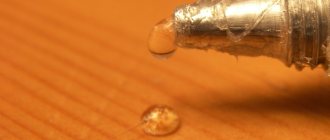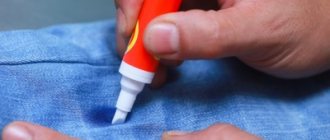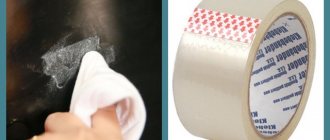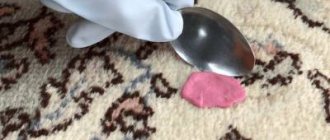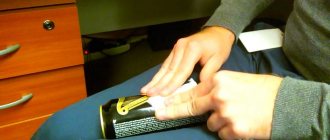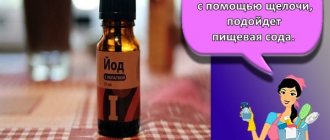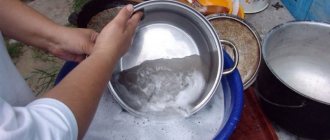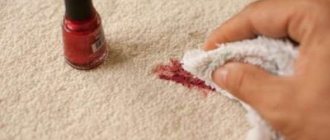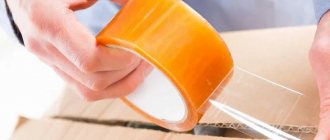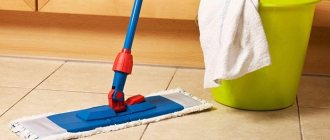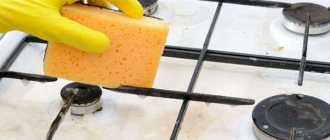Scotch tape, although not the most reliable adhesive, is nice to use as a temporary solution for some purposes. For example, broken pieces of furniture are held together with tape until construction glue is purchased, torn parts of textbooks, toys, etc. Despite the fact that the tape does not always stay in place for a long time in the place where it is placed, traces of it remain difficult to remove.
Surely each of you has encountered the fact that after purchasing, for example, a microwave oven, there were strips of tape left on its body that were used to stick the price tag, and there was no way to completely remove it. Meanwhile, the adhesive tape remaining after removing the transparent tape darkens, collects dirt, and spoils life with its terrible appearance.
In this material we will look at how to remove glue from tape safely and quickly.
How to remove glue from tape?
Removing tape with oils
So, first of all, the tape can be removed with the simplest means that almost everyone has at home. We are talking about oils of plant origin. Let's look at the table to see what types of it we are talking about.
Table 1. Which oils can remove traces of glue from adhesive tape
| View | Description |
| This category includes vegetable oils that we eat, namely:
|
| Essential vegetable oils are extracts-concentrates of nutritious biological fluids of various plants. They can only form inside flowers, grass trees, etc. Moreover, their composition is very concentrated; these active substances have strong physiological and pharmacological properties. You can use the following as a tape remover:
|
The use of oils is safe, as they are natural solvents and are not capable of harming humans. However, it must be said that the individual occurrence of allergic reactions in people with hypersensitivity is still possible, therefore, when wiping the adhesive from the tape using oils, it is better to do this with gloves.
Oil removes tape marks best from:
- leather and leather products;
- leatherette;
- hard surfaces.
Removing traces of tape is not easy; you need to liberally sprinkle the stained area with oil and wait until all the dirt and sticky mass dissolve
Oil will not cope with removing adhesive tape from the surface of products whose materials absorb liquids, for example, fabric or unvarnished wood.
Step No. 1 - prepare the necessary devices
So, we have a surface contaminated with traces of tape, hard, leather or otherwise, which is unable to absorb liquid. Our task is to cleanse it, therefore, we should stock up on:
- vegetable oil (preferably essential oil, it acts more intensely);
- two clean napkins;
- a bowl of warm water;
- soap.
It is better to choose an essential oil for use that is colorless and has a slight odor so that you do not get a headache from using it. However, if you love the smell of a particular oil, you can use it without fear.
Prepare essential oil, cotton pad, rag and soap with warm water
For those who have any breathing problems, it would be wise to protect their respiratory system with a mask.
Having collected everything you need, we proceed to cleansing.
Step No. 2 – cleaning the contaminated area
Take the purchased oil and pour it onto the remaining glue, or saturate a cotton pad with it and apply the latter to the contaminated area. You will need to leave everything in this position for an hour and a half for the glue to soak. Then soak the new disc in fresh oil, rub it over the soaked glue and it will be removed.
Soak cotton pads in cotton wool and then apply them to the dirty surface to remove dirt.
Step No. 3 - wipe the oiled area
The last step of this procedure will involve using a damp, soapy rag. We wipe the surface treated with oil with it in order to prevent the stains from drying out, in case you bought a very cheap essential oil that contains non-volatile resins. By removing the remnants of this solution with soap, you will get a completely cleaned and fresh surface without traces of adhesive from the tape.
After oiling, using a sponge, rag or cloth soaked in soapy water, it is necessary to remove any remaining oil from the surface to be cleaned.
Folk recipes
The advantage of traditional methods is that there are many of them, and they are fundamentally different in the type of impact on pollution.
If emergency methods using improvised means do not help, you should use the experience of other people and try different methods until an effective one is found.
Soda
Soda is suitable for treating delicate polished and painted surfaces. It is used like this :
make a thick paste;- Apply the mixture to the stain in a thick layer;
- leave for a few minutes;
- Next, the contaminated area needs to be rubbed a little;
- wash off the soda with warm water;
- wipe dry.
The principle of using soda is similar to using dry cleaning powder . But, if the powder contains aggressive chemicals, soda does not contain them, which means it is suitable for washing a much wider range of surfaces. You can safely clean polishing, thin upholstery, etc. with it.
Vegetable oil
You can use simple sunflower oil, but essential oils have a better chance of removing dirt.
Cleaning process steps:
- apply the oil to the surface with a cloth or cotton pad;
- leave for 15-20 minutes;
- gently wipe with a dry sponge or cloth.
At the end of the procedure, you need to remove oil traces with warm soapy water or water. Finally, wipe dry.
To saturate the remaining glue on a vertical surface with oil, you need to apply a cloth moistened with oil to it. It should stick and last for 15-20 minutes.
Eraser
This method requires diligence and free time . But it allows you to remove old dirt from any surface without the risk of ruining the coating.
Use an eraser to carefully remove any adhesive residue from the edge of the stain.
As the eraser wears off, it turns into small specks; they need to be swept away as you work, otherwise you won’t be able to see where the tape has come off and where you still need to rub.
Hairdryer
A hair dryer is used as a tool to prepare the surface for further cleaning using any of the above methods. Heating with a hairdryer softens the glue, making it easier to clean off.
The main thing is not to overheat the coating, for which this is harmful. For example, it is better not to heat polished surfaces with a hairdryer.
Acid
Sometimes difficult stains that cannot be removed with special products can be cleaned with acid. To prepare the solution, you need to mix citric acid with warm water in proportions of 1 to 2 . Or you can take unstirred table vinegar.
The surface is treated and left for 10-15 minutes, then washed off with a wet sponge. If necessary, the procedure is repeated until the desired effect occurs.
Dentifrice
This tool is easy to use:
- first the powder is mixed with shaving foam (1 to 1);
- apply the mixture for 5 minutes;
- rub the stain with a sponge;
- when the stain disappears, the solution is washed off;
- the surface is wiped.
Remove glue from tape using an eraser
An eraser or eraser is a schoolchild’s best assistant, and now ours, ready to remove any remaining adhesive tape from any hard surface (or not hard, but one that can be rubbed).
This remedy is also low cost and safe. Its only downside is that your fingers can really get tired of wiping off traces of tape, especially if they have a large area.
The most common school eraser is an excellent tool for removing adhesive from tape.
The method of using the eraser is very simple.
Step No. 1 – stock up on the necessary materials
Buy a large piece of eraser at a stationery store, preferably medium hard, white, and not grainy, as you will have to spend a lot of it.
Also stock up on a cleaning cloth or a damp cloth with soap to use on the surface before and after the cleansing procedure.
Go to the store and buy the biggest white eraser you can find
Step No. 2 – clear the work area
In order not to make a mess and not waste an eraser on wiping off more easily removed dirt, you must first wash the area to be treated with a cloth with soap, or wipe with a cleansing napkin. This will take time, but after the final processing the effect we are interested in will be immediately visible.
Rub the eraser over the areas contaminated with tape, but first, preferably, remove the rest of the dirt from them
Step No. 3 - wipe off the glue
Start working intensively with your hands, using an eraser to rub away any traces of tape. They will come off very well, but this will require a lot of effort and physical strength.
Once the tape is removed, use the cloth to clean the treated area again until it is completely clean.
When finished, clean the area to be treated again with a cloth.
Marks on polished furniture
If the surface is smooth, any marks on it will be especially noticeable. But there are different ways to help get rid of traces of tape as quickly as possible.
Tape and sticker remover
To resolve the issue, you can use substances from the household chemicals departments in the store:
- Window cleaning products like “Mr. Muscle”, “Cinderella”, “Wedge”, and so on. They contain ammonia, which can easily cope with any plaque, regardless of the surface.
- Dry types of cleaning agents - “Komet”, “Pemolux” and others. They can be washed off five minutes after spreading over the surface. Rubbing does not require excessive effort.
An acceptable option is chlorine-containing cleaning gels, which, if necessary, can remove residual substances.
Special pencils
These are specially made compositions in the form of pencils, the main purpose of which is to remove traces of adhesive tape, including from household appliances. They are combined with ceramic surfaces, glass and plastic, from which something also often needs to be washed off.
Industrial solvents for removing tape marks
Some industrial solvents are also capable of removing either fresh or old tape stains without any problems. Among the list of all existing mixtures, the following work especially well:
- "White Spirit";
- solvent;
- pre-purified gasoline for refilling lighters;
- acetone;
- ordinary kerosene.
We would like to warn our readers: all of the substances listed above are highly toxic, therefore, working with it, especially for a long time, requires careful preparation.
Step No. 1 – preparation for cleansing
So, the first stage will be preparation. In our opinion, it should consist of two stages.
1. Find yourself protective ammunition, which should consist of:
- thick clothes with long sleeves;
- a respiratory mask through which you will breathe while you work;
- If possible, also prepare safety glasses so that the visual apparatus is also protected from harmful fumes.
2. The second stage is, in fact, the purchase of the necessary materials. In our case, they will be one of the industrial solvents listed in this section, as well as:
- dry woven napkin;
- cleaning wet wipe.
First, go to the store and buy a solvent from the list presented above, any that suits your price and is available from sellers.
At the same stage, you need to open the window so that toxic volatile substances evaporate better and do not harm your health. And at the same time, lay it in the place where you are treating traces of adhesive tape with toxic agents, so that drops flying onto the floor are not absorbed and do not spoil the flooring, while at the same time continuing to evaporate and poison your body.
At the same step, you must open the window, and only then you can start working
Step #2 – Start Cleaning
Take a dry cloth (after putting on all the protective gear) and soak it in the industrial solvent of your choice. From our point of view, it is White Spirit that works the fastest, and it is also easier to get, however, other means work no less effectively.
Start wiping away any traces of tape with a dampened napkin. You can first moisten the marks with the product and let them sit for a while, dissolving, and then start scrubbing them off. Even if specific contaminants have been in this place for many years and have absorbed all kinds of dirt, believe me, these products will remove them.
Apply solvent to the napkin, saturate it generously, and then begin to wipe off the surface contaminated with adhesive from the tape.
Step No. 3 - wash off the remaining product with soapy water
After cleansing, the cleaned area must also be treated with soapy water and wiped clean, since the remnants of the toxic industrial solvent, if not removed, will continue to evaporate from it and poison your body.
There is no need to use any stronger products than soap, just do not forget about this stage of processing.
When finished, wash the cleaned surface with soapy water and a cloth.
Rules for working with toxic solvents when wiping off tape
The human body is a fragile biological robot that can become ill when toxic substances enter its structures. In addition, working with such substances can already be dangerous for many different reasons. That is why we would like to discuss with you the main rules that must be strictly followed when interacting with industrial solvents.
the first important rule related to working with these substances above. It implies the mandatory wearing of protective equipment:
- clothes;
- and accessories.
When working with solvents, be sure to wear a mask, safety glasses and thick, closed clothing.
So, you don’t have to buy special clothes, you can just wear a long-sleeved shirt and pants with full-length trousers. In principle, this will be enough, although it is also desirable that the neck be closed.
As for accessories, it is imperative to wear a mask to prevent toxic fumes from entering the respiratory tract, as well as glasses so that the fumes do not irritate the mucous membrane of the eye and cause serious damage to your vision.
The second rule is this: you cannot do such work near fire. Of course, all these substances are highly flammable, they ignite quickly and are very difficult to extinguish. Fire will spread extremely quickly in contact with them, and can potentially cause irreparable harm to you, your family members and real estate. To prevent this from happening, it is necessary to work with toxic fumes only away from potential sources of ignition.
The solvent ignites easily, to prevent a fire, work with it in a room where there are no sources of ignition
The third rule is that you can only work with the substances we described above in the open air, or, if this is not possible, with open windows. Thus, the room will be ventilated more intensively, and all harmful substances will evaporate without having time to settle or permeate objects, and also “climb” into your respiratory system.
Work with solvents only near an open window or outside the living space, if possible.
Fourth rule. When working with these substances, make sure that no one else is in the room. It is best to lock it from the inside with a key to prevent accidental entry into the premises:
- your family members;
- pets.
Pay special attention to the fact that these fumes are the most dangerous for animals and children.
The fifth rule implies mandatory cleaning of the surface treated with these substances with soapy water and a dry cloth so that they do not settle on the surfaces and do not harm your health.
Types of furniture
Furniture can be glass, wood, or upholstered. Depending on the quality of the surface, not all methods are suitable and give a positive result.
Glass
For glass and mirror parts, you can use any method. In this case, the use of even the most aggressive substances is suitable:
- solvent;
- petrol;
- alcohol;
- vinegar;
- special aerosols.
Avoid dry cleaning powders that damage the surface during friction.
Important. Treatment of tinted glass with potent substances is undesirable, so as not to compromise the integrity of the window.
Wooden and polished
When varnished, polished, painted furniture, gentle methods are used. Traditional methods:
- vegetable or essential oil;
- school eraser;
- foam based on soap, dishwashing gel.
If the wooden surface is not treated, then use products that evaporate easily without leaving stains:
- medical alcohol;
- acetone;
- White Spirit;
- gasoline for lighters.
Soft
The uneven surface and absorbency of the fabric creates some difficulties when removing tape from furniture. Tape that has been glued for a long time is absorbed deeper, and it is more difficult to remove it. The following methods are applicable for this.
- You can use paper and a hot iron. Apply a clean sheet several times and then iron it.
- In case of failure, use solvents.
- Alcohol and acetone are suitable for leather and non-fading fabrics. If it is possible to wash the material, pre-soak it.
Important. Do not use gasoline and oil, as they can cause greasy stains.
Removing tape marks with nail polish remover
Nail polish remover is a transparent liquid, usually tinted in blue, pink or greenish shades, which has both a pleasant (thanks to the perfume composition) and a pungent (thanks to acetone) odor. It is due to this that the varnish is dissolved and removed from the surfaces of our nail plates.
Nail polish remover is a tool that can also help us remove annoying traces of tape
As you might have already guessed, nail polish remover should also work if you need to remove traces of tape. Let's consider the technique of its application.
Step No. 1 – getting ready for work
So, in order to work with nail polish remover, we do not need to prepare as seriously as when working with industrial solvents, since this liquid contains only a fraction of acetone, that is, it is less concentrated, and therefore dangerous. Therefore, before working with it, we only need to prepare:
- rubber gloves (not necessary, but why stain your skin with a toxic substance once again, we’re not removing nail polish);
- mask (to avoid inhaling rapidly evaporating compounds);
- the nail polish remover itself (more);
- cotton pads;
- clean napkins.
At the same stage, we open the windows and expel animals, children and adults whose faces are not protected by masks from the room.
Be sure to also prepare a face mask to prevent inhalation of the tape remover.
Please note: when purchasing nail polish remover, or using a bottle you have lying around at home, check that the packaging says “with the addition of acetone.” Some liquids are now produced without adding this solvent. Having purchased such a liquid, you are unlikely to be able to successfully use it for our purpose.
Step #2 – Soak tape stains in liquid remover
As we already wrote above, nail polish remover is a much less concentrated liquid than pure acetone. By the way, only this active substance can overcome the remnants of adhesive tape; the rest of the liquid’s composition cannot do this, therefore, so that we do not have to exert an excessive amount of effort, we need to soak the contaminated area in the product.
Soaking is done like this:
- Our product is applied to a cotton pad (or pads);
- discs stick to contaminated surfaces;
- wait two to three hours, during which the fleeces are re-wetted with liquid.
Soak the surface contaminated with glue in nail polish remover
In this case, the cotton wool prevents the liquid from evaporating too quickly, and at the same time does not allow it to drain. By the way, don’t be afraid to simply stick the discs on vertical surfaces; when wet, they “stick” well to any material.
Step No. 3 - erase the remaining adhesive from the tape
So, thoroughly soaked adhesive from tape will be quite easy to remove with a new disc dipped in nail polish remover. Wipe the entire surface thoroughly, and then you can moisten another disc with water and wipe off the remaining acetone.
The cleaned surface is wiped with a damp cloth.
How to remove marks from masking tape
Once the masking tape dries, the hardened adhesive can be quite difficult to remove. You can scrape or sand, but this may accidentally damage the surface that the tape was originally intended to protect.
Luckily, there are many methods for safely removing dried masking tape, and they all work to varying degrees—if one method doesn't work, just try another.
- Start with the gentlest method - warm water and a damp cloth. Wet the cloth and wipe it over the dry tape. Let the water soak in for a few minutes, then carefully peel off the tape. Re-wetting the surface will help soften the adhesive and loosen the paper tape. You may need a razor blade to remove any remaining adhesive.
- Turn on the hair dryer and direct a stream of hot air at the old tape from a distance of about 10 cm. The warm air should soften the glue within a couple of minutes and allow the tape to be carefully peeled off. Monitor this process carefully to ensure that the heat does not damage the surface under and around the masking tape.
- Use commercial solutions such as wood cleaning soap, spray lubricants (such as WD-40), and commercial hand cleaning cream to moisten and revitalize the adhesive on the tape and make the tape easier to peel off. Here again you may need a razor blade to remove any remaining small pieces of paper and glue.
- Using chemical solvents such as mineral spirits or lacquer thinner can help soften the adhesive surface of the tape so you can simply wipe off the residue.
Removing adhesive from tape with vinegar
Vinegar is a delicate product that, compared to the substances we presented above, is considered gentle and is suitable for use on delicate materials, for example:
- children's clothing;
- toys;
- expensive furniture;
- painted surfaces, etc.
Unfortunately, it will be quite difficult for vinegar to deal with old marks, but you can try soaking the tape in it, or combining the effect of this substance with other safe products, such as oils.
Acetic acid can also be used to remove tape marks while treating delicate surfaces.
By the way, if you use table vinegar, not apple vinegar, there will be no traces left, which is especially pleasing for woven materials.
Please note: you must also wear gloves when working with vinegar. In addition, it has a pungent odor, and it is better not to smell it on purpose, as this can be dangerous.
How to remove tape from metal
Metal products are subject to slight deformation, so almost all options are suitable for removing the sticky layer: from soap and oil solutions to aggressive substances and hot air treatment. The metal is not afraid of mechanical cleaning by scraping. Substances with abrasive particles help this well. Often the sticker is removed from the metal coating without leaving any residue.
Freezing
If the item you want to remove tape residue from is small, place it in the freezer for 30 to 60 minutes and then scrape it off. If this option is not suitable, you can “freeze” the adhesive layer using a piece of ice or coolers that are used for thermal bags. Just press the ice against the glue for a few minutes and then try to peel it off. Several approaches may be required.
Window cleaner to remove tape marks
Another gentle remedy. Best of all, which is logical, it will clean windows and other glass surfaces from traces left by the tape, however, it will also do a great job on other hard objects. Don't write it off until you try it.
Of course, this product is gentle and will not cope with every contamination, however, it is necessary to have it in your arsenal. Of course, it is better to work with it with gloves, but in principle you will not need any additional protection to interact with it.
Window cleaner is a gentle substance that perfectly removes stains from adhesive tape from the surface of windows and other glass products.
What to do with plastic surfaces?
How to remove protective film from plastic windows.
Removing protective film from plastic frames is not an easy task. The first thing to remember: the “fresh” the stickers, the easier it will be to remove them. If circumstances are such that you need to deal with tightly glued stickers or double-sided tape, then proceed step by step. First, melt the dried glue using a regular hair dryer, and only then wash it with your usual cleaning products.
How to remove advertising stickers from household appliances.
When purchasing any household appliances, ask store managers to remove the stickers. This will not be difficult for them, since they use special means for these purposes.
Scotch tape marks on the washing machine.
If you have to clean the equipment yourself, then try using acetone, alcohol, or an alcohol-based window cleaner. When using these products, experiment on an inconspicuous area first. Some types of plastic may lose color or become dull when combined with alcohol, keep this in mind.
If you don’t risk using aggressive substances, try removing dirt with an ordinary eraser. Just as you would erase a pencil from paper, wipe the glue off the stained surface. The eraser will not damage the plastic, but, on the contrary, will delicately remove any remaining glue. Dirty pellets can be removed with a damp cloth or cloth.
It has become difficult to find anything in any home that is not made of plastic. Furniture, electronics, toys for children, light bulbs, lamps and much, much more... These things are also contaminated with adhesive from tape, and it also needs to be removed so that the item is pleasant to use.
In order to erase traces of adhesive tape, the best means are the same as those used to remove stains from furniture. The use of oil will be especially beneficial: in the case of plastic, it cannot be absorbed into the surface and only acts to benefit the situation: it changes the physicochemical properties of the glue, making it soft and pliable for removal. By the way, plastic surfaces that are connected to glass (for example, windows) can also be easily washed using oil.
We suggest you read: How to remove tape marks from plastic
The eraser again shows itself to be an “angel”, since it again helps owners and housewives to clean dirt without harming the surface. All work comes down to carefully erasing the glue with an eraser and then brushing away the resulting pellets.
Gasoline, which should be used with caution when working with furniture, continues to be an aggressor when working with plastic. Yes, plastic is less susceptible to damage by gasoline, but if not used correctly, it can be hopelessly damaged. For example, a noticeable light stain may appear on the surface that cannot be washed off.
A hairdryer is again an auxiliary tool. It will help to scrub and wash away stains from adhesive tape, regular or double-sided. True, plastic can be of such poor quality that it can begin to melt due to the flow of hot air, so you should be careful when preparing the surface for cleaning. If the house has plastic windows and they are stained with adhesive from tape, a hairdryer will help perfectly, since high-quality plastic is used in the manufacture of windows.
At the beginning of the article, the list included such products as vinegar, alcohol, acetone and glass cleaner. We specially saved them “for the hottest”. With these four powerful ingredients, you can effectively remove glue stains from your household appliances.
Vinegar is perhaps the safest remedy among those listed. It allows you to easily wash off the glue and, if there are any, pieces of the adhesive tape itself, extremely sticky fragments of double-sided tape, and it does it carefully and certainly will not leave a light stain on the surface. True, old stains are beyond the power of vinegar.
Acetone can be called a stronger version of vinegar because it can remove old stains too. True, if the surface is painted, it can dissolve the paint, which, of course, is undesirable. But acetone really helps with any degree of contamination.
The cleaner for windows and other glass surfaces is slightly weaker than acetone, but it is much safer, since it will definitely not spoil the item being cleaned. In addition, if household appliances have a glass surface, it is very convenient to simultaneously wash glue stains, other contaminants (if any), and fingerprints.
It’s easy to wipe off stains even from double-sided tape, especially if you know all the pitfalls. We hope that our article was informative and helped you in cleaning your window, furniture or floor from dirt.
Removing tape with homemade cleaning products
Non-aggressive removal of not too thick and old adhesive from adhesive tape can be provided by household cleaning products.
1. Dishwashing gel, diluted in high concentration in hot water and highly foamed, will help remove this contamination from various surfaces. The resulting foam must be applied liberally to the glue and allowed to fall off several times, reapplying, and preferably more than once. The soaked glue is removed with a napkin or scraped off with a knife.
Dish soap can also help you remove the tape.
2. If you make a paste by mixing baking soda and water, you will also be able to get rid of disgusting tape stains. True, you need to apply the slurry generously, and let it soak, eat away the tape, and only then remove it with a napkin, and finally clean the surface with clean water.
Please note: soda is an abrasive substance, and it must be used very carefully on products that can be scratched, that is:
- painted;
- varnished;
- glass.
Use regular baking soda
3. Another home remedy that may come in handy is special formulations designed to remove labels and their traces. They can be sold in the following formats:
- spray;
- stick;
- liquids.
Each product will be effective only when used on a specific surface, so this issue must be clarified in advance in the store when purchasing it.
Adhesive remover
Removing traces of glue from plastic parts
Plastic does not tolerate many types of cleaners, so you need to be careful when working with this material.
Best to use:
liquid detergents or shampoos;- baking soda;
- White Spirit;
- citric acid;
- vinegar.
Dish soap or shampoo
Shampoo, like dishwashing detergent, contains components that cope well with various types of dirt. After soaking the sponge in the solution, you should thoroughly soap the problem area.
After a while, the sticky glue will begin to come off. After completing the manipulation, the surface must be wiped with a soft cloth.
White Spirit
To prevent the plastic from becoming dull, it is better to mix the liquid with detergent and carefully wash off the dirt.
Baking soda
Baking soda helps quickly remove sticky marks and restores the shine of the surface. This powder removes old stains.
The area where the glue has dried is lightly moistened with water, then soda is applied to the wet spot.
After 2-3 minutes, when the powder has dissolved a little, you can begin to scrub off the dirt. It should give in quickly. If cleansing is difficult, you can also add a little citric acid.
Lemon acid
In the absence of vinegar, you should use lemon juice. It is poured onto the contaminated area, after which the remaining glue and powder are easily removed. Squeezing lemon juice and leaving it on the surface for 7-10 minutes can help.
Vinegar
Vinegar is called a natural solvent that does not spoil plastic and does not leave marks on it.
After soaking a cloth in the liquid, you need to wipe the sticky area. By combining vinegar with soda or citric acid, you can quickly get rid of even severe stains.
Removing remaining tape with a drill
A drill can remove the tape marks for you. Put a rubber nozzle on it and use it to treat a contaminated surface with old dirt, however, try to make the revolutions at medium intensity so as not to damage the surface.
This can be done on almost any hard surface, but it is better not to touch household appliances or other electronics, as vibration from the drill may damage them.
A special attachment on the drill will help you effectively remove remaining tape.
How to clean using household chemicals?
You can remove glue stains using cleaning products and detergents intended for other purposes.
Dishwashing liquid
This product can be used to clean almost any surface, except those that cannot be wet.
The method of use is simple:
- pour warm water into the ladle;
- add a few drops of detergent;
- moisten a sponge in the resulting solution;
- start rubbing.
The intensity of friction depends on the type of coating. So, polished or painted wood should be processed carefully, without strong pressure. And upholstery made of leather or leatherette can be well rubbed without fear of ruining it.
After treating with a soap sponge for 1-2 minutes, you should collect the foam with a clean rag and see if the tape comes off or not.
If it is not washed off completely, but the stain has decreased, the procedure should be repeated . If after rubbing the stain does not decrease, then you need to use another, more aggressive product.
Dry cleaning powders
The powder can be used to clean a hard, chemical and mechanically resistant surface. For example, this method is suitable for cleaning kitchen appliances or bathroom surfaces.
It is very easy to use:
First, the powder is applied with a damp sponge;- left for a few minutes;
- then rub the stain with the hard part of the sponge;
- during friction, the powder turns into a liquid soap mass, it should be washed off with water;
- if the stain has disappeared, the surface must be wiped dry;
- If the contamination remains, repeat the procedure until it completely disappears.
Glass products
If the product contains alcohol, it can be used to scrub an unpainted hard or soft surface . It is sprayed onto the contaminated area and then wiped with a sponge or soft cloth, depending on the type of surface.
After treatment, allow the stain to dry. And, if traces of glue remain, you need to do the procedure again.
Any chosen method, even the most gentle one, must first be tested on a small area of the surface.
Soap solution
You can remove glue stains using a solution of water and regular soap:
- the soap solution is applied with a sponge;
- the surface rubs a little;
- the remaining soap is washed off with a clean rag.
You can try to remove glue soaked in soapy water with a hard, non-sharp object, for example, a wooden kitchen spatula.
Removing tape stains with tape
You will be surprised, but fresh tape is very effective in getting rid of stains. Stick it on the marks from the other tape, smooth it, and then sharply, with all your strength, peel it off. Of course, if the stains were old, the result is not guaranteed, however, in this way you will definitely keep the surface being treated safe and sound.
The wedge is knocked out with a wedge, and we remove the stain from the tape by re-applying this device to the contaminated surface
Scotch
Pre-heat the tape slightly with a home hair dryer, stick the same strip on it, press with some force, then very carefully and slowly pull up. Place it on the area stained with the previous tape and pull it sharply upward. Usually this is enough. Didn't manage to wash off the dirt from the adhesive tape the first time? Repeat several techniques!
Removing tape from fabrics
Fabrics are perhaps the most delicate surface from which it is not at all easy to remove tape. However, sometimes they get dirty too, and then we have to figure out what to do. So here's what we can do in this case.
1. First, try removing the tape using a piece of paper and an iron. To do this, place a regular white A4 sheet on the contaminated fabric, then iron it several times with a hot iron. The paper will have to take over all the glue.
Various means can help remove traces of tape from fabrics.
2. If the paper trick doesn't work, it would be wise to remove the mark with solvents. It is best to use acetone or alcohol, for example, for fabrics that do not fade, as well as for leather surfaces. However, if you stain bright, printed items, you will simply have to wash them several times, first soaking them in a soda solution.
Please note: it is better not to use gasoline or oil on fabrics, as you will then have to remove grease stains, which is even more difficult.
How to clean double-sided tape from furniture
With double-sided tape, both sides are sticky; the intermediate layer of foamed polyurethane comes in different thicknesses - from 0.5 to 1.6 mm. The glue can be rubber or acrylic based. This tape is particularly reliable; it is quite difficult to remove double-sided tape from furniture. A quick method is a drill with a special rubber attachment designed for polishing surfaces; it removes dirt very quickly and effortlessly, without scratching the coating.
The second method is to heat the remaining tape with a hairdryer until soft, and then carefully remove it (not suitable for polished surfaces).
In order to remove stains from glass and mirror parts, the use of solvents (white spirit, gasoline, acetone) remains relevant.
You can try to wipe off the sticky mass mechanically: pry the edge with the tip of a knife and pull, stick a strip of masking tape over the foam base, press for greater adhesion and slowly peel it off from the furniture surface.
Let's sum it up
Adhesive tape is an indispensable household item that allows you to discreetly repair almost any product, at least temporarily. However, removing traces after using it is very, very difficult; this is a job for the most resourceful. In this article, we have presented a far from exhaustive list of tools that will help you deal with the annoying layer of glue that collects all the dirt and dust. Don't despair, keep trying and you will succeed.
If you follow these recommendations and do not forget the iron on the board, then the risk of damage to the fabric and surface of the device is very small. However, if carbon deposits do appear on the iron, it is better to clean the soleplate in a timely manner so as not to spoil things and your own mood. How to do it? Read in the special article.
Video - How to remove tape stains
Vegetable oil
Everyone has it. Rub it onto any dirty area on your item and let it work for a few minutes. Due to the incompatibility of the two ingredients (oil + glue), foam will result. Then carefully wipe it off and, lo and behold, everything is clean. Of course, now it’s clear how to wash off traces of corrosive tape - vegetable oils, and the problem is solved!
Just don't do the same with fabric-upholstered items.
Cleaning rules depending on the type of surface
The choice of cleaning agent should be based on the material from which the furniture is made.
Glass surfaces
Glass surfaces can withstand intense chemical exposure . They can be processed:
- soap products,
- alcohol-containing compounds;
- special aerosols for removing glue.
Stationery tape can be washed off with regular soap. Double-sided adhesive tape, or rather traces of it, can be removed from the surface with chemical compounds.
You cannot heat the glass with a hairdryer. Cleaning with a drill is prohibited. These methods can lead to the glass simply cracking.
It is not advisable to clean glass with powder and soda, since these products consist of small particles that can cause minor scratches.
Read more about removing tape marks from glass surfaces here.
Wood materials: painted or polished
Painted or polished wood can be cleaned:
- oil,
- soda,
- eraser
- or liquid detergent (if applied very carefully).
It is not advisable to heat the wood and apply special sprays to it (only in case of severe contamination from double-sided tape).
It is strictly prohibited to wash wooden coverings using solvents or alcohol-based products , as this will lead to damage to the covering.
Plastic
Plastic furniture can be cleaned using a variety of cleaning products. It is undesirable to use only dry cleaning agents and soda - scratches may remain. However, the concept of plastic is very broad, in some cases it is a rather capricious and delicate material.
In order not to spoil the plastic product, before starting full cleaning, you should definitely try the selected product on an inconspicuous small area of the surface.
Stationery tape can be removed by soaking it with soapy water. It is better to remove strong double-sided tape with a spray.
Learn more about removing tape marks from plastic surfaces in this article.
Cushioned furniture
Upholstered furniture can be tidied up using :
- soap solutions,
- detergent,
- special sprays.
For severe dirt, you can heat it with a hairdryer. It is better not to use a solvent - if it does not corrode the material, it will be absorbed into it and the furniture will smell bad.
It is also undesirable to use tooth powder , since it is difficult to wash out from fabric surfaces and may leave a whitish trace.
Special means
Household cleaning chemicals are available in the form of sticker pencils, aerosols and liquids. The former are useful for removing dirt from small surfaces. They do not have an unpleasant odor. Sprays are universal. They are easy to apply, work quickly and can smell pleasant thanks to flavoring additives. Liquids require more care when applying as they are more concentrated. They are also harder to apply to stains.
If finances allow, you can buy household chemicals. The most popular drugs for removing contaminants are:
- Duty Scotch . A universal product that will also help clean the cabinet of dirt left by adhesive tape. It is a preparation based on several solvents at once. It is sprayed onto the surface or applied with a sponge, and after 5 minutes it is removed with a dry cloth.
- Glutoclean Pufas . Easily and quickly dissolves the adhesive base of adhesive tape. Leave for just a couple of minutes and remove the residue with a napkin.
- Berner Tape Cleaner . A convenient aerosol that will remove dirt in 5 minutes. Has a pleasant citrus aroma.
- Grass "Antigraffiti " Composition based on organic solvents and terpene oils. Spray onto the stain and leave for 1-10 minutes depending on the contamination.
- Antistick . Spray cleaner. Exposure time – 3-5 minutes.
There are also special products on sale for removing labels and stickers that will remove traces of tape. Read the instructions for use carefully before applying to furniture. If used incorrectly, many products can not only remove glue, but also damage the surface of cabinets and walls.
Any substance must first be tested in a small area. The solvents included are usually strong. Therefore, they can damage furniture.
You only need to work with the products when the windows are open. Wear protective gloves and a mask.
